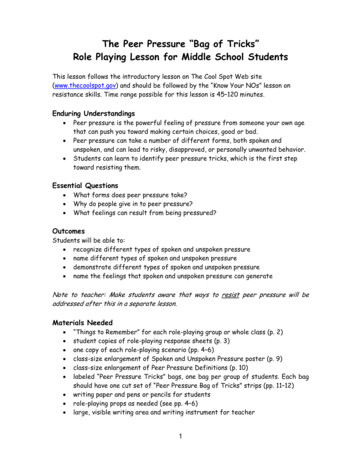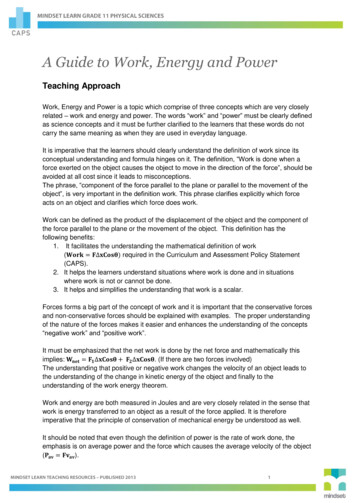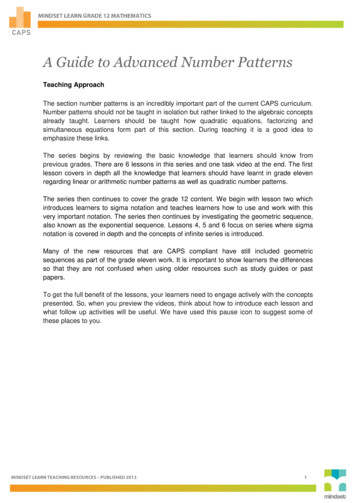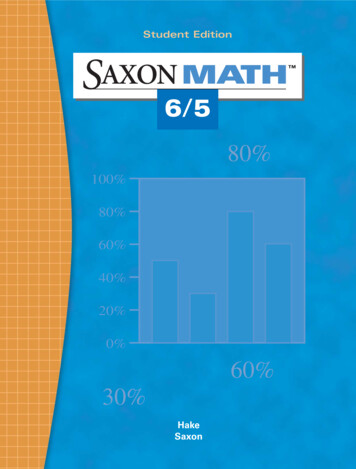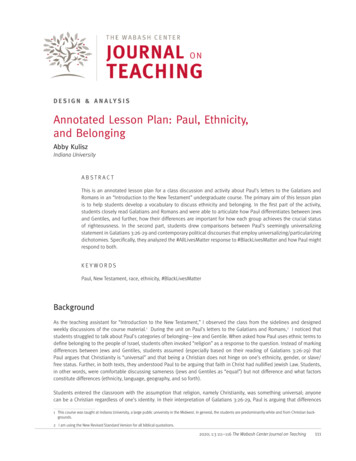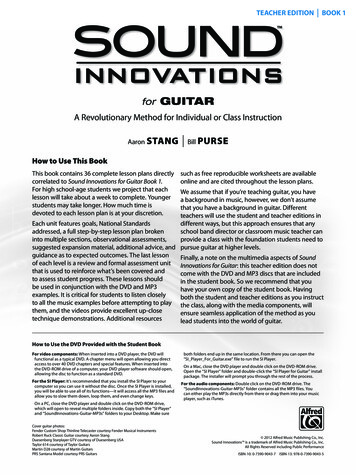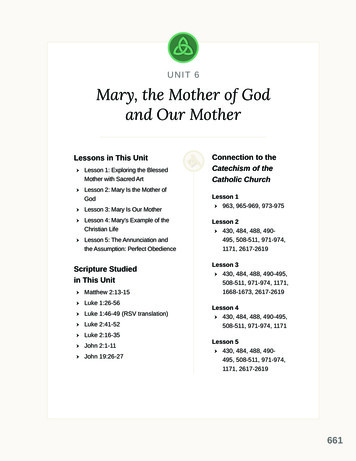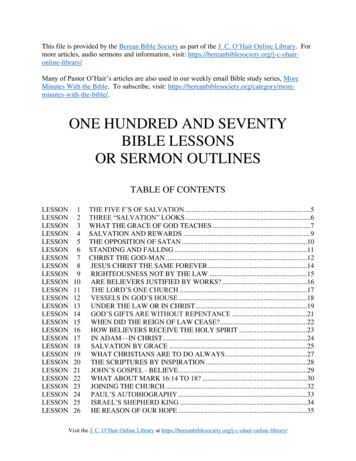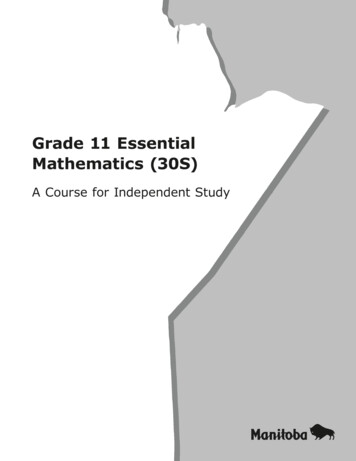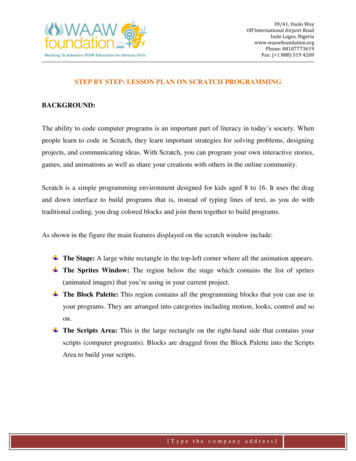
Transcription
39/41, Osolo WayOff International Airport RoadIsolo Lagos, Nigeriawww.waawfoundation.orgPhone: 08107773619Fax: ( 1 888) 519 4269STEP BY STEP: LESSON PLAN ON SCRATCH PROGRAMMINGBACKGROUND:The ability to code computer programs is an important part of literacy in today’s society. Whenpeople learn to code in Scratch, they learn important strategies for solving problems, designingprojects, and communicating ideas. With Scratch, you can program your own interactive stories,games, and animations as well as share your creations with others in the online community.Scratch is a simple programming environment designed for kids aged 8 to 16. It uses the dragand down interface to build programs that is, instead of typing lines of text, as you do withtraditional coding, you drag colored blocks and join them together to build programs.As shown in the figure the main features displayed on the scratch window include:The Stage: A large white rectangle in the top-left corner where all the animation appears.The Sprites Window: The region below the stage which contains the list of sprites(animated images) that you’re using in your current project.The Block Palette: This region contains all the programming blocks that you can use inyour programs. They are arranged into categories including motion, looks, control and soon.The Scripts Area: This is the large rectangle on the right-hand side that contains yourscripts (computer programs). Blocks are dragged from the Block Palette into the ScriptsArea to build your scripts.[Type the company address]
39/41, Osolo WayOff International Airport RoadIsolo Lagos, Nigeriawww.waawfoundation.orgPhone: 08107773619Fax: ( 1 888) 519 4269TIME ALLOWED: 90 minutesCLASS OUTCOMEBy the end of this lesson, students will learn the following:Understand and appreciate computer programming/coding as a basic tools in our presentsocietylearn to think creatively, reason systematically, and work collaborativelyLearn how to program by creating simple animations using computer code with scratch totell stories, create games and share ideas.Create simple programs that will help them develop a range of coding and problemsolving skills and also help them when they later move onto real-world programming.MATERIAL(s):A computer or mobile phone with scratch installedINTRODUCTION (5 minutes)Start by asking the students the following questions and allow them to give you answer beforeintroducing them to what computer programming is.[Type the company address]
39/41, Osolo WayOff International Airport RoadIsolo Lagos, Nigeriawww.waawfoundation.orgPhone: 08107773619Fax: ( 1 888) 519 4269What is computer programming? Comment: computer programming is simply writing aset of codes or commands that allows you to perform a specific task.Why do we need to learn how to program? Comment: programming is tool in oureveryday activity with applications in almost all fields ranging from agriculture,technology, science, medical, art and so on.What programming languages and skills do you know or have heard about? Comment:programming languages include JavaScript, Java, BASIC, FORTRAN, C , HTML etc.Have you heard of scratch programming? If you have, what is it about? Comment:scratch is programming platform that teaches beginners how to code in a fun way byusing simple animations.ACTIVITY (50 minutes): Activity is subdivided into stagesStage 1 (15 minutes): In this stage the students will learn how to change costume andbackground, select sprite (animated objects) and make use of commands from Motion and Lookscategories from the Block Palette.To change background:To change costume:click on the white rectangle shape named stageclick on the cat spriteclick on import and select from optionsclick on importclick okselect from options and click okNote: you can select more sprite and background by using same method. Also you can changethe name of sprite to a more suitable name.Using commands from Motion category: This category introduces the commands that allowthe sprite to move forward/backward, rotate sprite clock/anticlockwise and position sprite in anydirection and so much more. Examples of commands to explore here are shown below[Type the company address]
39/41, Osolo WayOff International Airport RoadIsolo Lagos, Nigeriawww.waawfoundation.orgPhone: 08107773619Fax: ( 1 888) 519 4269Using commands from Looks category: This category introduces the programming blocks thatallows you to switch between costume and backgrounds, display a speech/thought bubble withits corresponding message. The message is presented permanently or for fix duration of time.It allows you to set or change graphic effects applied to sprite, change size of sprite, show/hidesprite on stage, move sprite in front other sprite.Stage 2 (10 minutes): Students will learn how to use commands from the Sound and Pencategories from the Block Palette.[Type the company address]
39/41, Osolo WayOff International Airport RoadIsolo Lagos, Nigeriawww.waawfoundation.orgPhone: 08107773619Fax: ( 1 888) 519 4269Using commands from Sound category: This lesson introduces the programming blocks thatallow you to play sounds, drums and instruments associated with the sprite while you eithercontinue with other actions or wait until the sound ends. It also introduces the control to stop allsounds.Using commands from Pen: this block allow us to put the pen down, and therefore draw as itmoves, or to move the pen up, disabling the pen from marking as it moves. The clear blockremoves all the pen marks from the Stage. It also introduces the programming blocks that allowsus to set or change the pen color, set or change the shade of the pen, set or change the pen sizeand to stamp on the stage images of the sprite.Stage 3 (15 minutes): students will learn how to navigate between sprites by making use ofcommands from Control, Sensing and variables categories of the Block Palette.Using commands from control category: The blocks presented on this category allows us toactivity the sprite either by clicking on the green flag, clicking on the sprite or clicking on anykey in the keyboard based on chosen option, it also allows you to wait for a predefined timebefore performing an action which helps to navigate between sprites actions and many more.Here are some command options from the control,[Type the company address]
39/41, Osolo WayOff International Airport RoadIsolo Lagos, Nigeriawww.waawfoundation.orgPhone: 08107773619Fax: ( 1 888) 519 4269Using commands from sensing category: these blocks helps you to receive information aboutthe location of the mouse coordinates, x and y, it tells you if one sprite is touching another sprite,the distance of one sprite to another or to the mouse pointer and many more.Using commands from variables: This presents the programming blocks allows you to knowthe current time of the timer in seconds as well as the current volume of the sound and allowsyou to reset. Here are few commands from the variablesStage 4 (10 minutes): students will learn how to use commands from the operators categoryUsing commands from the operator: These blocks allow you to perform arithmetic operationssuch as the division, addition, subtraction and multiplication. It allows you to generate randomnumbers, compare numbers and use the logic operations.[Type the company address]
39/41, Osolo WayOff International Airport RoadIsolo Lagos, Nigeriawww.waawfoundation.orgPhone: 08107773619Fax: ( 1 888) 519 4269Note: using and combining more of these commands from the different categories helps thestudents to better understand the program and build more competent skillsDISCUSSION (5 minutes)Find out what each student has learnt; how useful is this program to them, what their challengeswith the program is and how you can help them better understand the program.GROUP PROJECT (25 minutes)After studying the tutorials the students will replicate on their own Scratch environment theactivities presented during the lesson. The students are encouraged to explore, beginning with theenvironment presented in the tutorials, all the possibilities open by the newly learned concepts.Divide the students into groups with at most four (4) students in each group, give each groupaccess to a computer and task each group to create and build programs based on storytelling andgames using commands from at least four (4) categories in the block palette.To Launch your project online: register on MIT code lab and upload your project to the site foreveryone to see and you can also get more information and ideas on how to develop your scratchskills from this site.CLOSING REMARKS AND EVALUTION OF STUDENT PROGRESS (5 minutes)Rate the performance of your students from a range of 5 – 1 (5 as excellent and 1as poor). Keepthe track of the record from this program for future references.[Type the company address]
The ability to code computer programs is an important part of literacy in today’s society. . Scratch is a simple programming environment designed for kids aged 8 to 16. It uses the drag and down interface to build programs that is, instead of typing lines of text, as you do with traditional c



